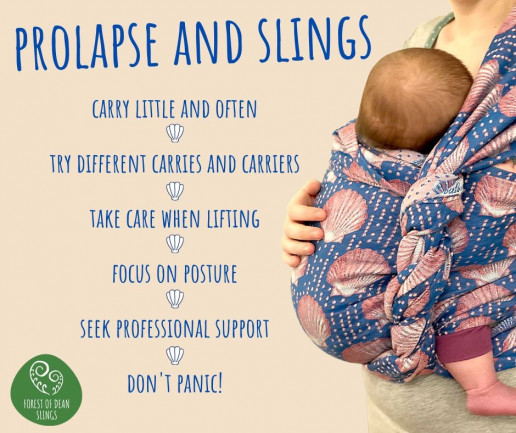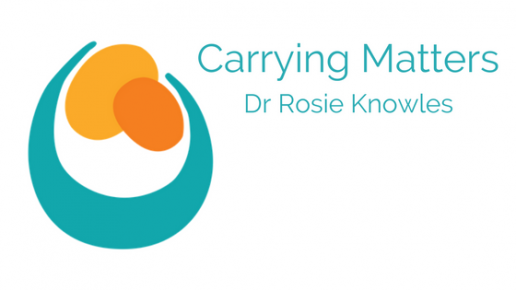Pelvic Organ Prolapse is common, and can make babywearing complicated. Here is a super post from Nelly Brewer at Forest of Dean Slings on this topic.
Original post by Nelly Brewer can be seee here
🌸 BABYWEARING AND PROLAPSE 🌸
A personal perspective
Pelvic organ prolapse, where one or more pelvic organs bulge into the vaginal cavity, affects A LOT of people who have given birth. If you’ve been diagnosed with, or suspect you may have, prolapse, you may be wondering if it’s safe to carry your baby in a sling or soft carrier.
The answer is – probably! I discovered my prolapse 3 weeks after my first child was born. I’m not a medical professional, but I have gained a great deal of personal insight over the last few years into managing prolapse symptoms, and how to combine this with safe and comfortable babywearing. Below are my thoughts on carrying and prolapse based on my own journey.

🌸 Carry little and often 🌸
It’s super disappointing to not be able to go on a 4 mile walk through the woods with your newborn. I’ve been there. It sucks. But carrying little and often in a well fitted carrier can help build core muscle strength while reducing further damage. It’s very easy to overdo it, so if you do have a day with a lot of carrying, try to rest the following day. It’s OK to feel frustrated by these limits. Be kind to yourself while you adjust your expectations of your postpartum body.
🌸 Try different carries and carriers 🌸
Carriers are like jeans – different styles suit different wearers and there is no ‘one size fits all’ carrier – whatever the box might say! It’s a good idea to visit your local sling library to try out some different styles, or book a session with a carrying consultant to explore as many options as you can.
Some people with prolapse dislike buckle carriers with firm, structured waistbands, which can constrict and put pressure on the lower abdomen, especially when combined with poor posture. Buckle carriers with less structured waistbands, meh dais and woven wraps might be a better option for some wearers.
You may also find that hip or back carrying places less strain on your pelvic floor than front carrying, particularly when using a carefully tightened woven wrap. Most buckle carriers are suitable for back carrying from around 6 months. Woven wraps can be used for younger babies, but you may want to seek support from a trained carrying consultant before you do so.
🌸 Take Care when Lifting 🌸
Heavy lifting, pushing and pulling is not good for prolapse. Always engage your pelvic floor and breath out when lifting your baby (or anything else!). When moving your baby onto your back in a carrier, a hipscoot or seated lift may be a better option than the ‘superman toss’. Avoid carrying your baby in the car seat wherever possible. A carrier is a much better option for getting your baby to and from the car, and taking them round the supermarket, to baby groups or the health centre.
🌸 Focus on Posture 🌸
Existing poor posture may be exacerbated by the extra load of a baby in a sling, putting extra strain on the back, core and pelvic floor muscles. Paying attention to your posture and taking steps to correct it can help with managing prolapse symptoms both with and without a baby in a carrier.
🌸 Seek professional support 🌸
It’s a good idea to seek support from a trained carrying consultant to help you find a carrier that works for you. It’s also a good idea to seek professional support for your prolapse symptoms. This could include physiotherapy sessions with a women’s health specialist, a low intensity exercise programme focussing on core and pelvic floor strength, and the use of a silicone pessary to support your pelvic organs. In the UK, your GP will be able to signpost you to available NHS services. Be persistent if you’re not offered the support that you need!
🌸 Don’t Panic! 🌸
Prolapses that develop soon after birth have a good chance of improvement even without treatment, but it can take a couple of years. The body produces a hormone called relaxin during pregnancy to loosen the ligaments in the pelvis, and relaxin levels can take a while to reduce after birth, particularly when breastfeeding. It can be really hard to be patient, but hang in there! However, even if your symptoms do go away, it’s important to continue to protect your pelvic floor health.
Further reading about carrying with a postnatal pelvic floor can be found here.

